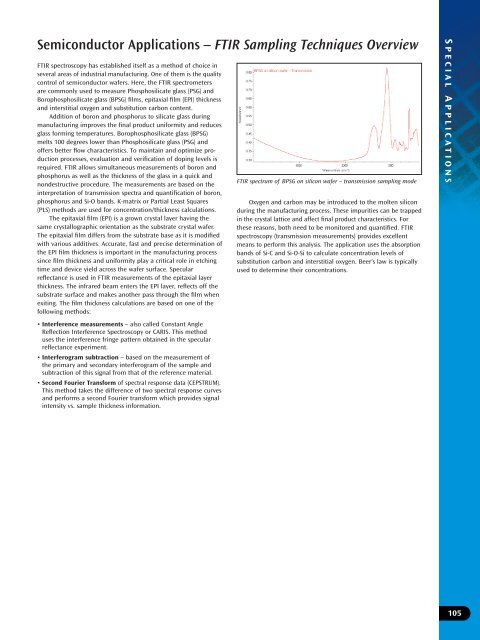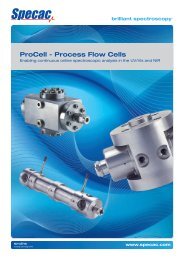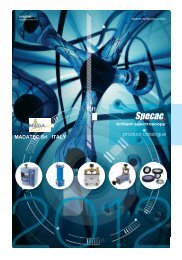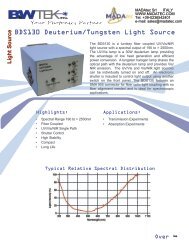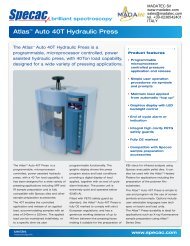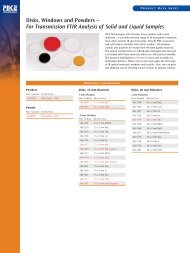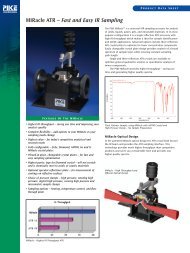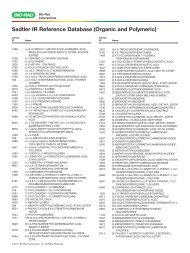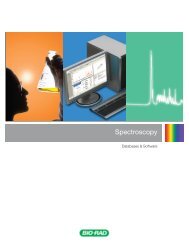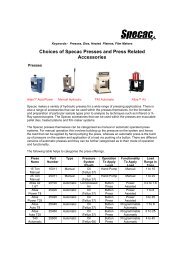Pike Technologies Comprehensive Catalog of FTIR ... - Madatec
Pike Technologies Comprehensive Catalog of FTIR ... - Madatec
Pike Technologies Comprehensive Catalog of FTIR ... - Madatec
Create successful ePaper yourself
Turn your PDF publications into a flip-book with our unique Google optimized e-Paper software.
Semiconductor Applications – <strong>FTIR</strong> Sampling Techniques Overview<br />
<strong>FTIR</strong> spectroscopy has established itself as a method <strong>of</strong> choice in<br />
several areas <strong>of</strong> industrial manufacturing. One <strong>of</strong> them is the quality<br />
control <strong>of</strong> semiconductor wafers. Here, the <strong>FTIR</strong> spectrometers<br />
are commonly used to measure Phosphosilicate glass (PSG) and<br />
Borophosphosilicate glass (BPSG) films, epitaxial film (EPI) thickness<br />
and interstitial oxygen and substitution carbon content.<br />
Addition <strong>of</strong> boron and phosphorus to silicate glass during<br />
manufacturing improves the final product uniformity and reduces<br />
glass forming temperatures. Borophosphosilicate glass (BPSG)<br />
melts 100 degrees lower than Phosphosilicate glass (PSG) and<br />
<strong>of</strong>fers better flow characteristics. To maintain and optimize production<br />
processes, evaluation and verification <strong>of</strong> doping levels is<br />
required. <strong>FTIR</strong> allows simultaneous measurements <strong>of</strong> boron and<br />
phosphorus as well as the thickness <strong>of</strong> the glass in a quick and<br />
nondestructive procedure. The measurements are based on the<br />
interpretation <strong>of</strong> transmission spectra and quantification <strong>of</strong> boron,<br />
phosphorus and Si-O bands. K-matrix or Partial Least Squares<br />
(PLS) methods are used for concentration/thickness calculations.<br />
The epitaxial film (EPI) is a grown crystal layer having the<br />
same crystallographic orientation as the substrate crystal wafer.<br />
The epitaxial film differs from the substrate base as it is modified<br />
with various additives. Accurate, fast and precise determination <strong>of</strong><br />
the EPI film thickness is important in the manufacturing process<br />
since film thickness and uniformity play a critical role in etching<br />
time and device yield across the wafer surface. Specular<br />
reflectance is used in <strong>FTIR</strong> measurements <strong>of</strong> the epitaxial layer<br />
thickness. The infrared beam enters the EPI layer, reflects <strong>of</strong>f the<br />
substrate surface and makes another pass through the film when<br />
exiting. The film thickness calculations are based on one <strong>of</strong> the<br />
following methods:<br />
• Interference measurements – also called Constant Angle<br />
Reflection Interference Spectroscopy or CARIS. This method<br />
uses the interference fringe pattern obtained in the specular<br />
reflectance experiment.<br />
• Interferogram subtraction – based on the measurement <strong>of</strong><br />
the primary and secondary interferogram <strong>of</strong> the sample and<br />
subtraction <strong>of</strong> this signal from that <strong>of</strong> the reference material.<br />
• Second Fourier Transform <strong>of</strong> spectral response data (CEPSTRUM).<br />
This method takes the difference <strong>of</strong> two spectral response curves<br />
and performs a second Fourier transform which provides signal<br />
intensity vs. sample thickness information.<br />
<strong>FTIR</strong> spectrum <strong>of</strong> BPSG on silicon wafer – transmission sampling mode<br />
Oxygen and carbon may be introduced to the molten silicon<br />
during the manufacturing process. These impurities can be trapped<br />
in the crystal lattice and affect final product characteristics. For<br />
these reasons, both need to be monitored and quantified. <strong>FTIR</strong><br />
spectroscopy (transmission measurements) provides excellent<br />
means to perform this analysis. The application uses the absorption<br />
bands <strong>of</strong> Si-C and Si-O-Si to calculate concentration levels <strong>of</strong><br />
substitution carbon and interstitial oxygen. Beer’s law is typically<br />
used to determine their concentrations.<br />
S PECIAL A PPLICATIONS<br />
105


